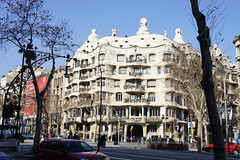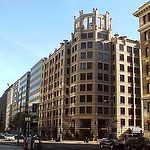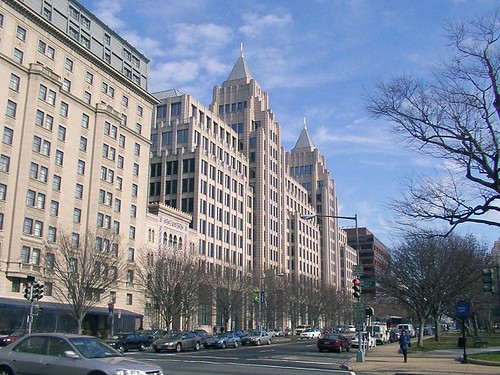 La Pedrera, Barcelona, product of height & form regulations even more strict than DC’s. Photo by Effervescing Elephant on flickr. |
There are plenty of good arguments for why DC’s height limit should be tweaked, but one that rings completely hollow is the claim it’s responsible for a bland, boxy streetscape, and DC would be more beautiful if only architects weren’t so constrained.
Any architect who says they can’t design a good or creative building under DC’s height limit is, to be blunt, a bad architect.
Brent Toderian at The Atlantic Cities discusses this same point (paraphrased):
Whenever I hear North American architects complaining that regulations or requirements “constrain architectural creativity, ” I think of Barcelona’s Passeig de Gracia boulevard and Paris’ Avenue des Champs-Elysees, which strictly regulate their buildings’ height, but still allow for great architectural beauty and nuance.
The easiest example is Gaudi’s La Pedrera, which acts as a “typical” corner building within Barcelona’s brilliant block plan that regulates height and form – and yet there’s nothing typical about Gaudi’s design.
It’s true that every city has rules that are both smart and dumb. Great architects know that genius often arises out of constraint.
It is true that DC’s regulations result in buildings with a boxy shape, but weird shapes are not the only way to make a building interesting, and anyone who thinks otherwise is intellectually bankrupt. No one would argue that K Street looks like Champs-Elysees, but that’s not because of the height limit. That’s because K Street’s buildings don’t have enough decoration.
Beautiful buildings can absolutely be produced within the context of DC’s height and form regulations, but to do so requires architects to step outside their 20th Century dogma that declares ornament to be the enemy. To do so requires architects to design something other than blank glass facades.
La Pedrera is an extreme example, handy for illustrating the point, but one does not need to go to Barcelona to see this fact in practice. Here are three relatively recent DC buildings that somehow have managed to be interesting, despite having to be designed within the context of the height limit.
You may or may not like these buildings, but they’re objectively not bland.
 |
 |
 |
But that’s not the only reason the “don’t constrain us” argument is so uncompelling. Another reason is that there is already a mechanism in place to allow height limit exceptions for primarily aesthetic architectural features. The prime example is the One Franklin Square office building, which received permission to break the height limit for a pair of decorative twin spires.

One Franklin Square.
So either way you look at it, the claim that DC’s height limit is responsible for bland architecture is simply not true. The world is full of examples of beautiful buildings produced in environments that constrained their size and shape, and even if it weren’t, DC’s regulations don’t actually constrain architects very severely.
Let’s continue to talk about the economic, social, and urban design issues facing the height limit question, but let’s put this one to bed. The height limit is not responsible for bland architecture in DC. At most, it’s a convenient excuse.
December 3rd, 2012 | Permalink
Tags: architecture, urbandesign













